Differential Effects of Various Cleaning Solutions on the Cleaning and Regeneration Performance of Commonly Used Polyester Fiber Material Air Filters
Abstract
:1. Introduction
2. Materials and Methods
2.1. Evaluation of Performance Parameters
2.2. Experimental Instruments
3. Results and Discussion
3.1. Influence of Filtration Velocity on Filtration Efficiency
3.2. Differences in Counting Filtration Efficiency
3.3. Influence of Filtration Velocity on Resistance
3.4. Quality Factor of Different Cleaning Solutions
4. Conclusions
- The filtration efficiency showed a trend of first increasing and then decreasing with an increase in the filtration velocity. The filtration efficiency when cleaning with water was higher than that when cleaning with the cleaning solution. The filtration efficiency for PM10, PM2.5, and PM1.0 increased from 0.3% to 3.5%, 0.7% to 6.3%, and 0.1% to 4.6%, respectively. At a velocity of 1.1 m/s, the filtration efficiency of the polyester filter material reached its maximum;
- Water could be used for cleaning twice for PM10 and once for PM2.5, and the cleaning solution could only be used for cleaning once for PM10;
- The counting filtration efficiency when using water was higher than that when using the cleaning solution. For particles with a diameter between 0.3 and 2.5 μm, the change in the counting filtration efficiency was relatively more significant, with a maximum difference of 3.8%;
- The quality factor showed a trend of first decreasing and then increasing with the increase in the number of cleaning times. For the QF value of PM10, the quality factor after cleaning with the cleaning solution was slightly higher than that after cleaning with water, with a maximum value of 0.0023 Pa−1. The QF values of PM2.5 and PM1.0 showed the opposite trend, with the quality factor after cleaning with water being slightly higher than that after cleaning with the cleaning solution, with maximum values of 0.0002 Pa−1 and 0.0008 Pa−1, respectively.
Author Contributions
Funding
Data Availability Statement
Conflicts of Interest
References
- Zhao, W.; Lestinen, S.; Kilpelainen, S.; Yuan, X.; Jokisalo, J.; Kosonen, R.; Guo, M. Exploring the potential to mitigate airborne transmission risks with convective and radiant cooling systems in an office. Build. Environ. 2023, 245, 110936. [Google Scholar] [CrossRef]
- Cakmak, S.; Dales, R.; Kauri, L.M.; Mahmud, M.; Ryswyk, K.V.; Vanos, J.; Liu, L.; Kumarathasan, P.; Thomson, E.; Vincent, R.; et al. Metal composition of fine particulate air pollution and acute changes in cardiorespiratory physiology. Environ. Pollut. 2014, 189, 208–214. [Google Scholar] [CrossRef] [PubMed]
- Zacharias, N.; Haag, A.; Lamprecht, R.B.; Gebel, J.; Essert, S.M.; Kistemann, T.; Exner, M.; Mutters, N.T.; Engelhart, S. Air filtration as a tool for the reduction of viral aerosols. Sci. Total Environ. 2021, 772, 144956. [Google Scholar] [CrossRef] [PubMed]
- Berry, G.; Beckman, I.; Cho, H. A comprehensive review of particle loading models of fibrous air filters. J. Aerosol Sci. 2023, 167, 106078. [Google Scholar] [CrossRef]
- Rana, A.K.; Mostafavi, E.; Alsanie, W.F.; Siwal, S.S.; Thakur, V.K. Cellulose-based materials for air purification: A review. Ind. Crop. Prod. 2023, 194, 116331. [Google Scholar] [CrossRef]
- Yin, H.G.; Li, Z.H.; Zhai, X.P.; Ning, Y.X.; Gao, L.; Cui, H.H.; Ma, Z.J.; Li, A.G. Field measurement of the impact of natural ventilation and portable air cleaners on indoor air quality in three occupant states. Energy Built Environ. 2023, 4, 601–613. [Google Scholar] [CrossRef]
- Yeganeh, F.; Chiewchan, N.; Chonkaew, W. Cellulose nanofiber/polyimide composites for highly-efficient air filters. Cellulose 2023, 58, 1–16. [Google Scholar] [CrossRef]
- Ciorîță, A.; Suciu, M.; Coroş, M.; Varodi, C.; Pogăcean, F.; Măgeruşan, L.; Mirel, V.; Ștefan-van Staden, R.L.; Pruneanu, S. Antibacterial Enhancement of High-Efficiency Particulate Air Filters Modified with Graphene-Silver Hybrid Material. Microorganisms 2023, 11, 745. [Google Scholar] [CrossRef]
- Cai, R.R.; Zhang, L.Z. Progress and perspective of polymer electret-based PM2.5 filtration: Efficiencies, regeneration, and energy implications. Energy 2023, 15, 128504. [Google Scholar] [CrossRef]
- Zhang, X.; Fan, Y.S.; Wang, H.; Zhang, J.X.; Wei, S.X.; Tian, G.J.; Xie, W. Experimental study on the structure and properties of modified nonwoven filter fibers by impregnation with carbon black. J. Eng. Fiber Fabr. 2020, 15, 1–7. [Google Scholar] [CrossRef]
- Yang, M.; Yang, B.; Zhang, X.; Wu, S.S.; Yu, T.; Song, H.; Ren, F.; He, P.C.; Zhu, Y.H. Experimental Study of the Factors Influencing the Regeneration Performance of Reduced Graphite Oxide Filter Materials under Water Cleaning. Materials 2023, 16, 4033. [Google Scholar] [CrossRef] [PubMed]
- Tian, E.Z.; Yu, Q.P.; Gao, Y.L.; Wang, H.; Wang, C.; Zhang, Y.P.; Li, B.H.; Zhu, M.F.; Mo, J.H.; Xu, G.Y.; et al. Ultralow Resistance Two-Stage Electrostatically Assisted Air Filtration by Polydopamine Coated PET Coarse Filter. Small 2021, 17, 2102051. [Google Scholar] [CrossRef] [PubMed]
- Park, S.S.; Lee, Y.S.; Lee, S.W.; Repo, E.; Kim, T.H.; Park, Y.; Hwang, Y. Facile Surface Treatment of 3D-Printed PLA Filter for Enhanced Graphene Oxide Doping and Effective Removal of Cationic Dyes. Polymers 2023, 15, 269. [Google Scholar] [CrossRef]
- Wu, Z.T.; Chen, X.; Li, G.X.; Tian, L.; Wang, Z.; Xiong, X.Q.; Yang, C.; Zhou, Z.J.; Pan, X.C. Attributable risk and economic cost of hospital admissions for mental disorders due to PM2.5 in Beijing. Sci. Total Environ. 2020, 718, 137274. [Google Scholar] [CrossRef] [PubMed]
- Liu, X.P.; Bian, S.S.; Chang, D.Q.; Mao, N.; Liu, J.X.; Sun, X. Effect of Water Cleaning on Performance of Air Filtration Medias. J. Filtr. Sep. 2012, 22, 6–10. (In Chinese) [Google Scholar] [CrossRef]
- Fenta, E.W.; Tsegaw, A.A. Study the effects of fiber loading and orientation on the tensile properties of date palm fiber-reinforced polyester composite. Polym. Bull. 2024, 81, 1549–1562. [Google Scholar] [CrossRef]
- Bagheri, G.; Schlenczek, O.; Turco, L.; Thiede, B.; Stieger, K.; Kosub, J.M.; Clauberg, S.; Pöhlker, M.L.; Pöhlker, C.; Moláček, J.; et al. Size, concentration, and origin of human exhaled particles and their dependence on human factors with implications on infection transmission. J. Aerosol Sci. 2023, 168, 106102. [Google Scholar] [CrossRef]
- Zhang, Q.X.; Sun, Q.Y.; Wang, R.; Chi, Y.L.; Shi, B. Controllably Adjusting the Hydrophobicity of Collagen Fibers for Enhancing the Adsorption Rate, Retention Capacity, and Separation Performance of Flavonoid Aglycones. ACS Appl. Mater. Interfaces 2023, 15, 18516–18527. [Google Scholar] [CrossRef]
- Zhang, M.; Zhang, G.; Lu, X.; Abuduwaili, A.; Di, T.; Liao, X.; Sun, D. Synthesis of novel high-performance adsorbent based on modified polyurethane/polysaccharidesfor wastewater treatment. J. Polym. Environ. 2024, 32, 2818–2834. [Google Scholar] [CrossRef]
- Sun, F.G.; Zhang, X.; Xue, T.; Cheng, P.; Yu, T. The Performance Testing and Analysis of Common New Filter Materials: A Case of Four Filter Materials. Materials 2024, 17, 2802. [Google Scholar] [CrossRef]
- Yu, W.Q. The Experimental Study of Air Filter Re-Cleaning Based on Ultrasonic Method. Master’s Thesis, Xi’an University of Architecture and Technology, Xi’an, China, 2022. (In Chinese). [Google Scholar]
- Zhang, X.; Ma, J.Y.; Wang, J.H.; Shi, H.X.; Guo, J.P.; Fan, Y.S.; Nie, X.X.; Guo, T.; Luo, X.X. Modifying the Fiber Structure and Filtration Performance of Polyester Materials Based on Two Different Preparation Methods. Langmuir 2023, 39, 3502–3511. [Google Scholar] [CrossRef] [PubMed]
- GB/T 14295-2019; Air Filter. China Environmental Science Press Administration for Market Regulation, Standardization Administration of the People’s Republic of China: Beijing, China, 2019.
- Zhou, H.; Qi, G.; Li, W.; Wang, Y.; Yuan, Z. Electrolyte-gated srcoo_(x) fet sensor for highly sensitive detecting pH in extreme alkalinity solution. Nano Res. 2024, 17, 3079–3086. [Google Scholar] [CrossRef]
- Zhang, K.; Shi, X.; Jiang, H.; Zeng, K.; Zhou, Z.; Zhai, P.; Zhang, L.; Peng, H. Design and fabrication of wearable electronic textiles using twisted fiber-based threads. Nat. Protoc. 2024, 19, 1557–1589. [Google Scholar] [CrossRef] [PubMed]
- Wang, C.; Du, Z.; Zhang, Y.; Ma, Z. Elaborating the 3D microstructural characteristics and strength softening mechanical mechanism of fiber-reinforced recycled aggregate concrete. Constr. Build. Mater. 2024, 436, 137009. [Google Scholar] [CrossRef]
- Fu, L.; Ding, W.; Zhang, L.; Zhang, S. Study on preparation and properties of ca/pla nonwoven filter materials optimized by response surface methodology. Fiber Polym. 2024, 25, 1675–1690. [Google Scholar] [CrossRef]
- Bian, Y.; Niu, Z.L.; Wang, S.J.; Pan, Y.; Zhang, L.; Chen, C. Removal of Size-Dependent Submicron Particles Using Metal−Organic Framework-Based Nanofiber Air Filters. ACS Appl. Mater. Interfaces 2022, 14, 23570–23576. [Google Scholar] [CrossRef]
- Zhou, Z.Q.; You, T.; Wang, D.; Pan, Z.Y.; Xu, G.L.; Liang, Y.; Tang, M. Conformal Build-Up of Functionalized Air Filters with Improved Air Cleaning and Bioprotective Traps. Adv. Funct. Mater. 2024, 34, 2306777. [Google Scholar] [CrossRef]
- Wu, S.; Ma, X.; Zhang, X.; Chen, J.; Yao, Y.; Li, D. Investigation into hydrogen induced fracture of cable bolts under deep stress corrosion coupling conditions. Tunn. Undergr. Space Technol. 2024, 147, 105729. [Google Scholar] [CrossRef]
- Wu, S.; Hao, W.; Yao, Y.; Li, D. Investigation into durability degradation and fracture of cable bolts through laboratorial tests and hydrogeochemical modelling in underground conditions. Tunn. Undergr. Space Technol. 2023, 138, 105198. [Google Scholar] [CrossRef]
- Wu, S.; Zhang, Z.; Chen, J.; Yao, Y.; Li, D. Characterisation of stress corrosion durability and time-dependent performance of cable bolts in underground mine environments. Eng. Fail. Anal. 2023, 150, 107292. [Google Scholar] [CrossRef]

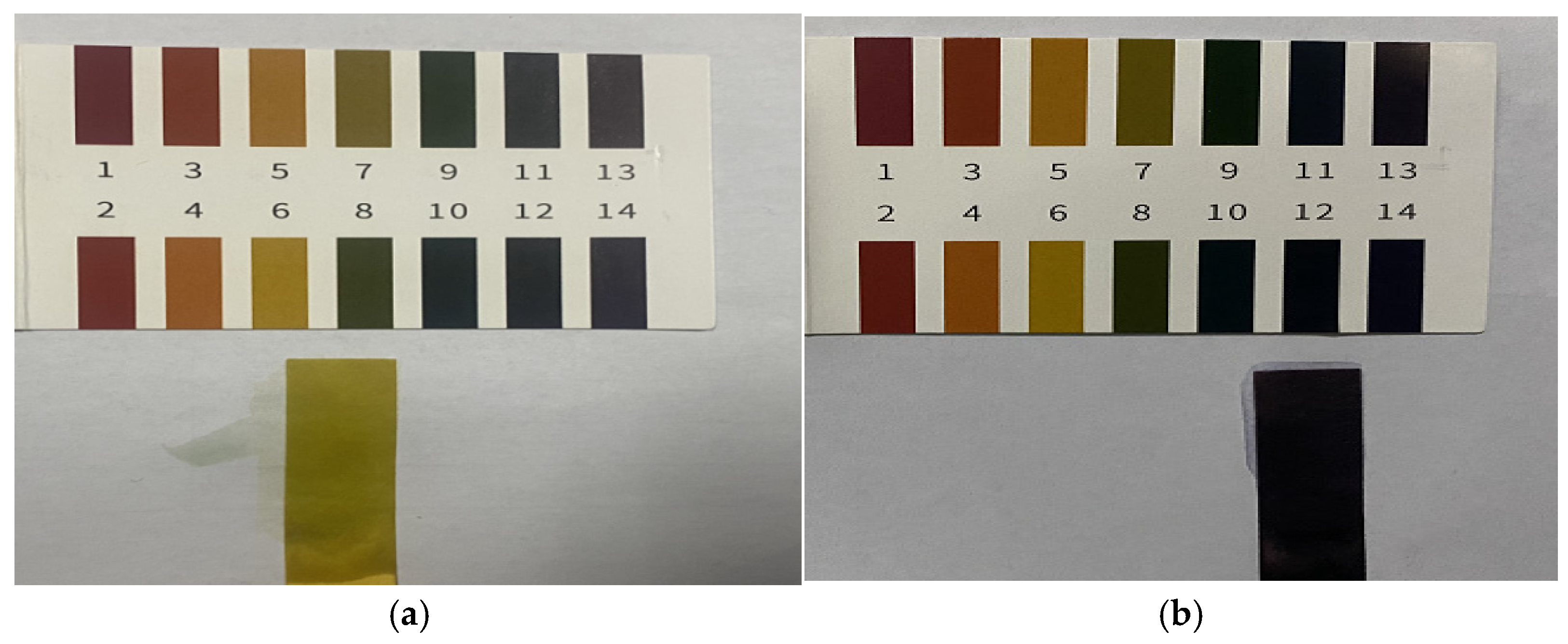

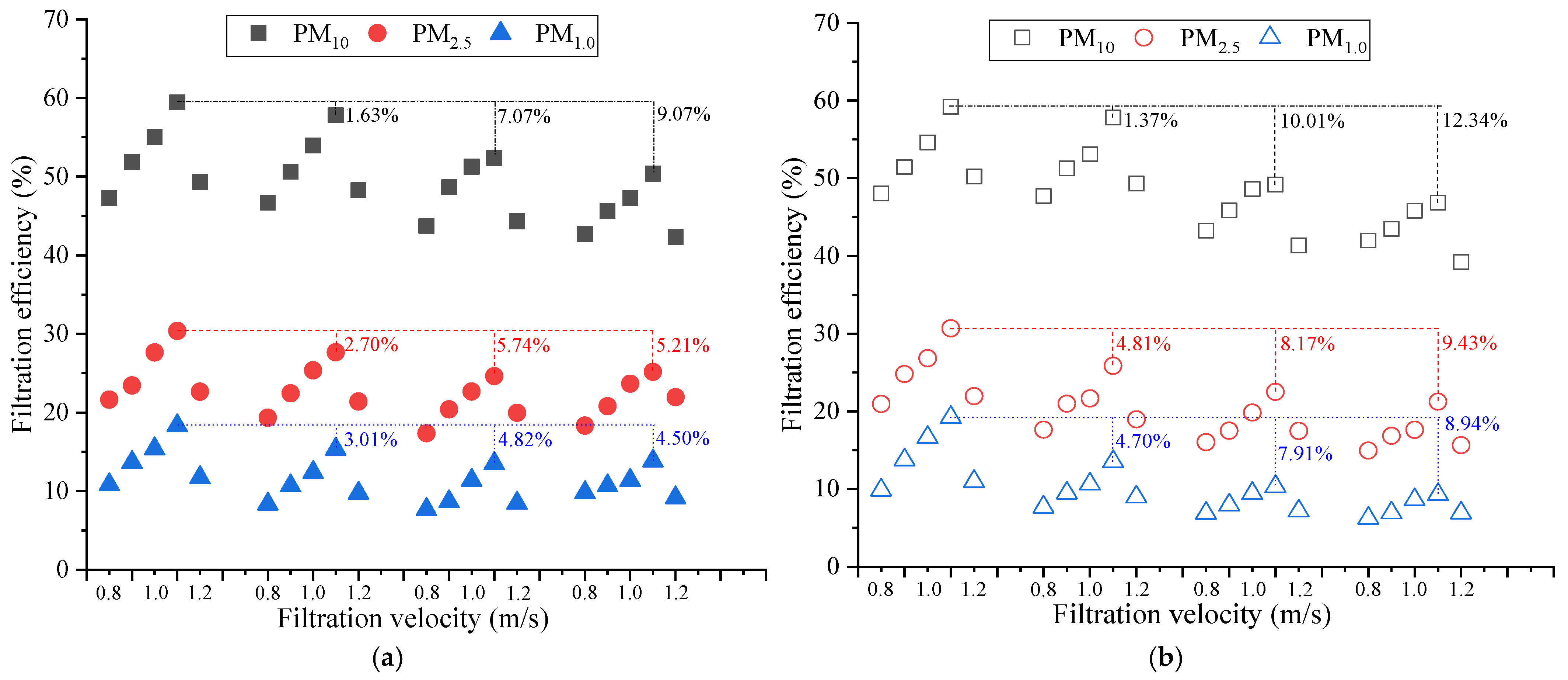

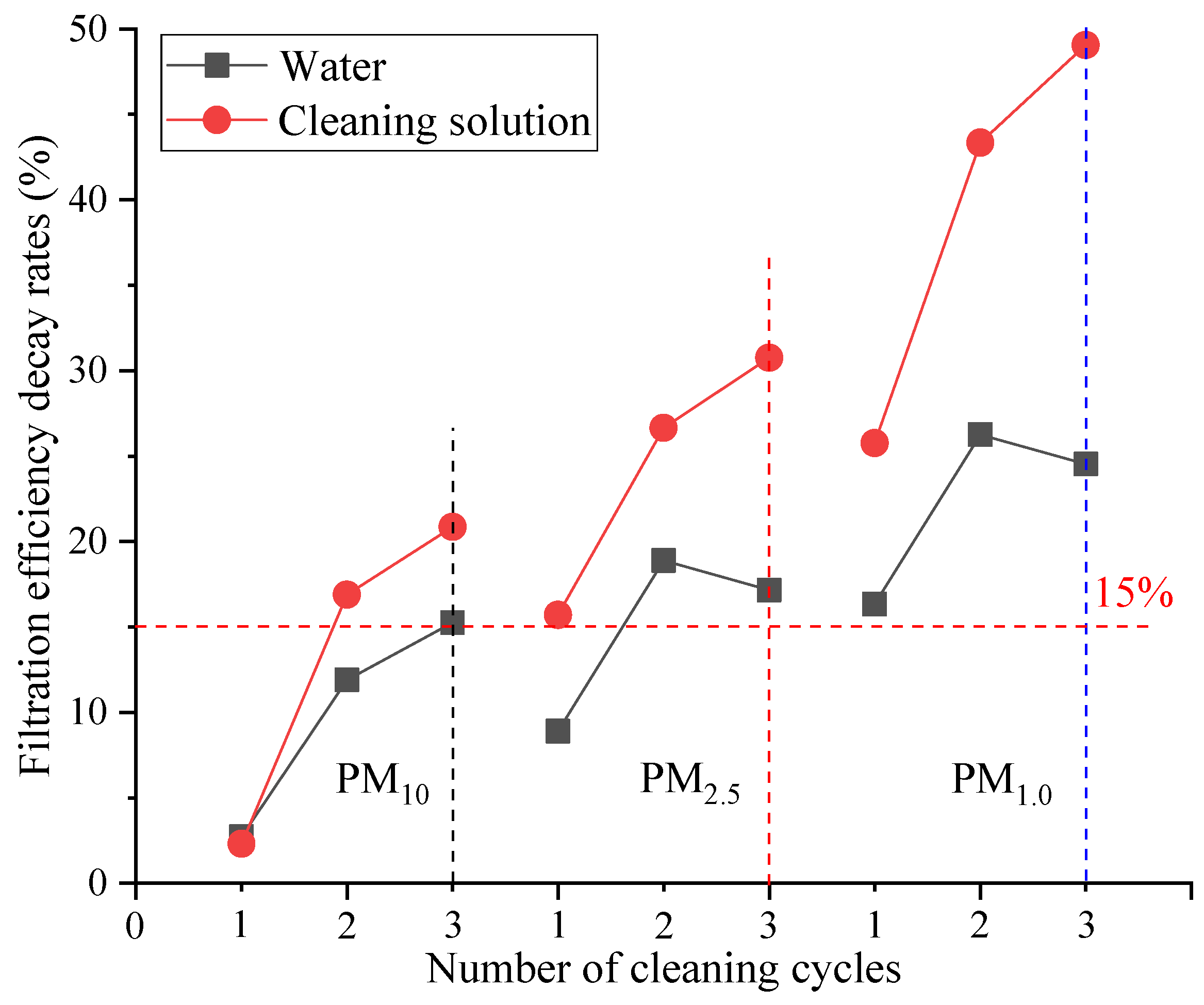

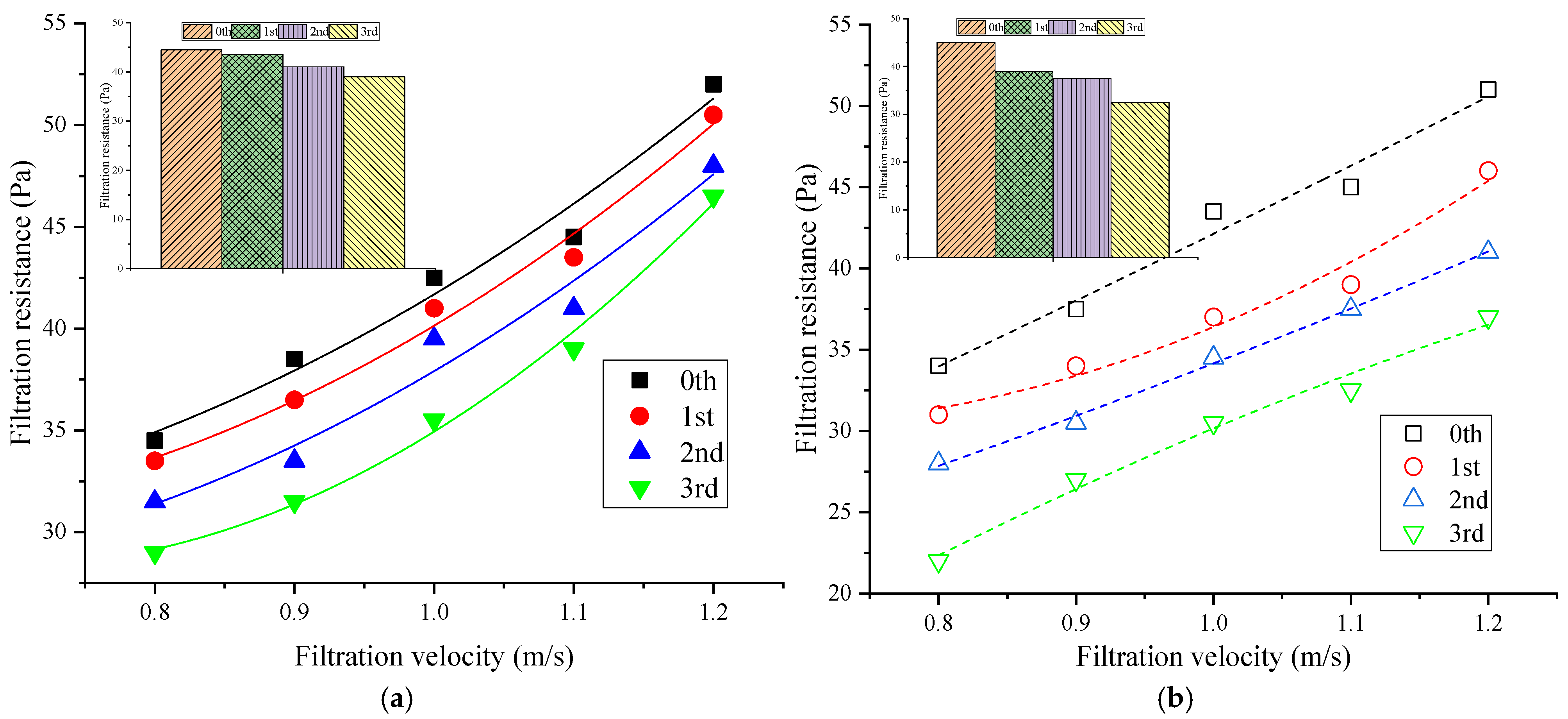

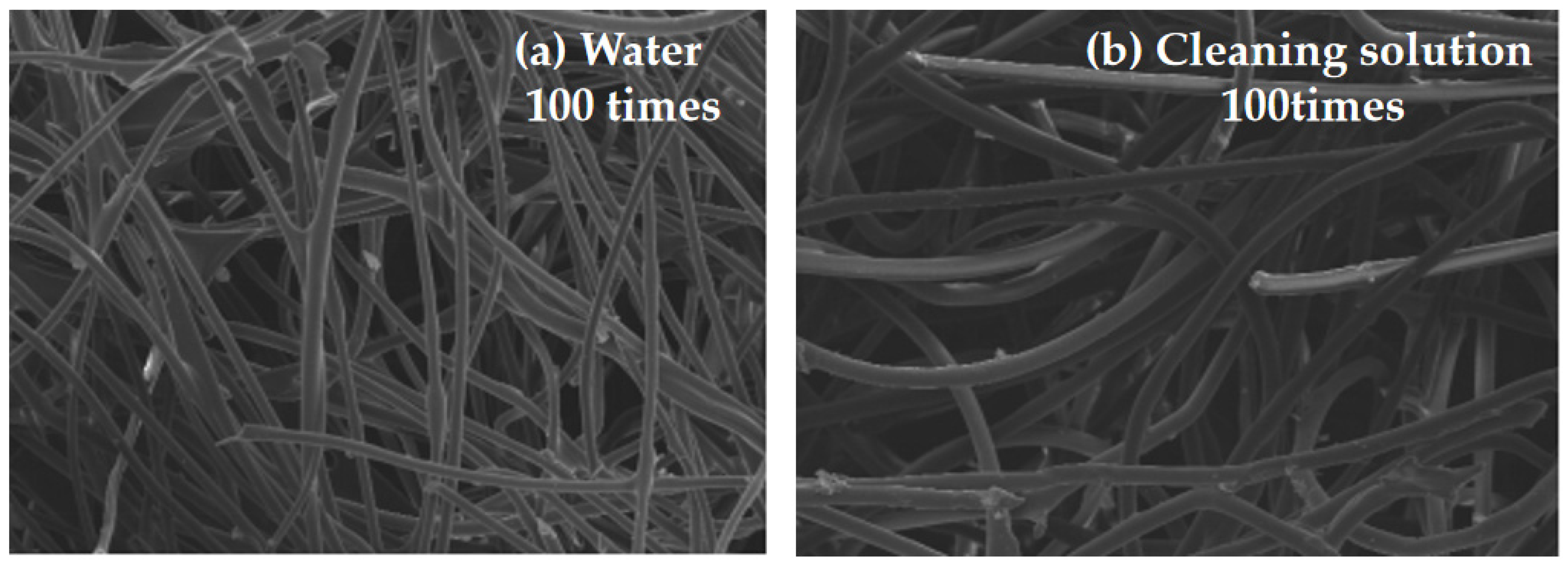
| Solution | Cleaning Times | Resistance Range (Pa) | Fitting Formula | Fitting Effect |
|---|---|---|---|---|
| Water | 0 | 34.5~52 | = 35.7v2 − 30.4v + 36.4 | R2 = 0.97523 |
| 1 | 33.5~50.5 | = 42.9v2 − 44.7v + 42.0 | R2 = 0.98654 | |
| 2 | 31.5~48.0 | = 39.3v2 − 38.1v + 36.7 | R2 = 0.97014 | |
| 3 | 29.0~46.5 | = 67.9v2 − 93.2v + 60.3 | R2 = 0.99348 | |
| Cleaning solution | 0 | 34.0~51.0 | = 3.6v2 + 34.4v + 4.2 | R2 = 0.97699 |
| 1 | 31.0~46.0 | = 50.0v2 − 65.0v + 51.4 | R2 = 0.97523 | |
| 2 | 28.0~41.0 | = 7.1v2 + 18.7v + 8.3 | R2 = 0.99699 | |
| 3 | 22.0~37.0 | = −17.9v2 + 71.2v − 23.2 | R2 = 0.98575 |
Disclaimer/Publisher’s Note: The statements, opinions and data contained in all publications are solely those of the individual author(s) and contributor(s) and not of MDPI and/or the editor(s). MDPI and/or the editor(s) disclaim responsibility for any injury to people or property resulting from any ideas, methods, instructions or products referred to in the content. |
© 2024 by the authors. Licensee MDPI, Basel, Switzerland. This article is an open access article distributed under the terms and conditions of the Creative Commons Attribution (CC BY) license (https://creativecommons.org/licenses/by/4.0/).
Share and Cite
He, P.; Zhang, L.; Li, Y.; Xue, W.; Zhang, X. Differential Effects of Various Cleaning Solutions on the Cleaning and Regeneration Performance of Commonly Used Polyester Fiber Material Air Filters. Processes 2024, 12, 2703. https://doi.org/10.3390/pr12122703
He P, Zhang L, Li Y, Xue W, Zhang X. Differential Effects of Various Cleaning Solutions on the Cleaning and Regeneration Performance of Commonly Used Polyester Fiber Material Air Filters. Processes. 2024; 12(12):2703. https://doi.org/10.3390/pr12122703
Chicago/Turabian StyleHe, Puchun, Lei Zhang, Yun Li, Wenqiang Xue, and Xin Zhang. 2024. "Differential Effects of Various Cleaning Solutions on the Cleaning and Regeneration Performance of Commonly Used Polyester Fiber Material Air Filters" Processes 12, no. 12: 2703. https://doi.org/10.3390/pr12122703
APA StyleHe, P., Zhang, L., Li, Y., Xue, W., & Zhang, X. (2024). Differential Effects of Various Cleaning Solutions on the Cleaning and Regeneration Performance of Commonly Used Polyester Fiber Material Air Filters. Processes, 12(12), 2703. https://doi.org/10.3390/pr12122703





